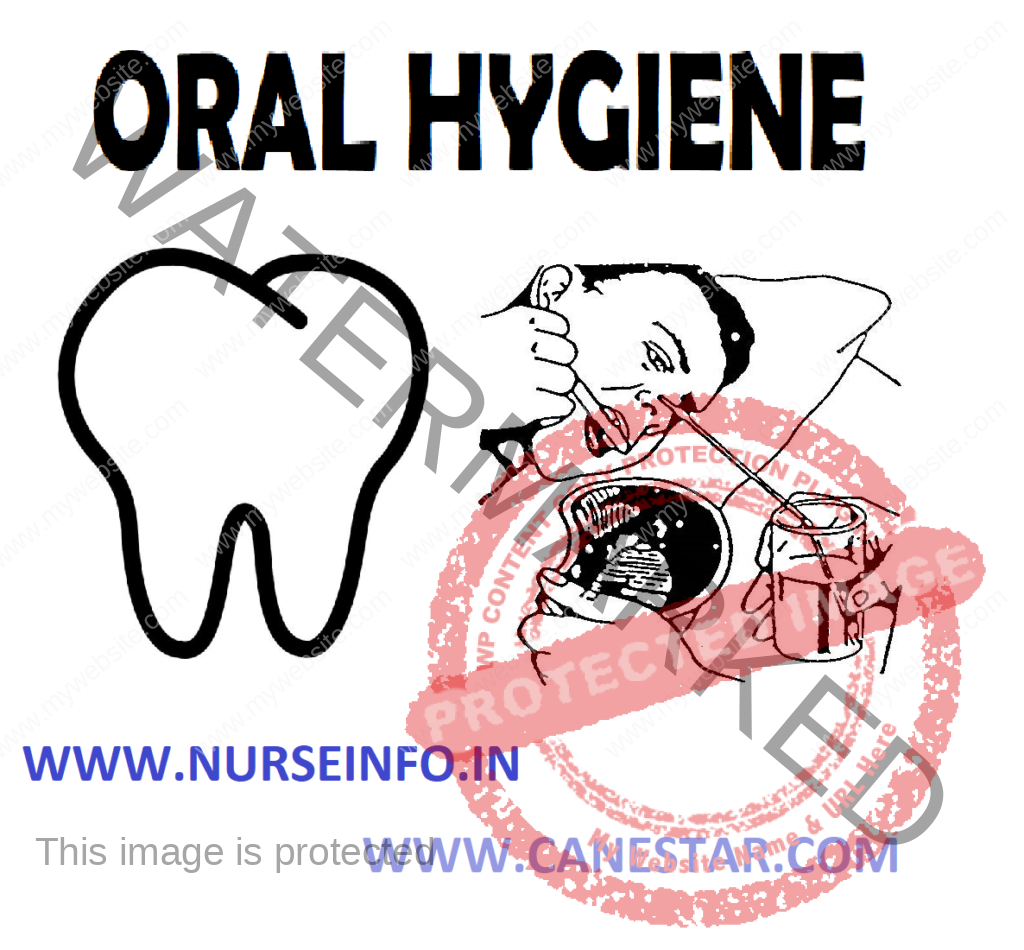ORAL HYGIENE Care of Independent , Dependent & Unconscious Patients , Care of Dentures

UPDATED 2024
Oral hygiene
means maintaining the cleanliness of the mouth. Oral hygiene includes measures
to prevent the spread of disease from the mouth and increase the comfort of the
patient

It is
important because mouth is the portal entry of food and digestion starts from
mouth. So, the entry of any pathogen in mouth directly affects health.
Oral hygiene
means the cleanliness of the mouth oral hygiene includes measure to prevent the
spread of disease from the mouth and increase the comfort

Objectives
- To keep the mouth and teeth in good
condition - To prevent the mucous membrane from
becoming dry and cracked - To prevent sores which resulting in
ulceration - To prevent bacterial in the mouth
from causing local and general infections - Emollients help to soften the dry
mucus membrane to prevent cracking
Purpose
- To prevent and treat mouth infections
- To keep the mouth fresh and clean
- To prevent the mucus membrane from
becoming dry and cracked - To prevent dental caries and tooth
decay - To prevent sores which resulting in
ulceration - To stimulate salivation and increase
appetite - To prevent infection of parotid
glands - To prevent complications such as
stomatitis, glossitis, pyorrhea and parotitis, etc - To stimulate circulation in gums thus
maintaining health firmness - To maintain oral hygiene among
bedridden patients
The Patient who may require Frequent Mouth Care
- Unconscious patients
- Helpless patient
- Patient with higher pyrexia
- Malnourished and dehydrated patients
- Patients who are not taking oral
feeds - Patients have local diseases of mouth
- Paraplegic patients
- Patients having a local disease of
mouth - Postoperative patients
Scientific Principles
- Any new treatment or exposure to
unfamiliar situation produces fear and anxiety - Food particles left in the mouth
promote the growth of microorganism - Soap which is constituent of most
dentrifrice has a low surface tension and spreads readily and penetrate in
between teeth - Cold water reduces friction and hot
water destroys dentures - Cough reflex is depressed in
unconscious patients - Giving mouth care provides
opportunity to observe the condition of mouth and teeth - Knowledge about the technique of
keeping the mouth healthy helps in practicing it and maintains - A clean mouth and teeth aids to the
patient a feeling of self-approval - Emollient help to soften the dry
mucous membrane to prevent cracking - Patients comfort and safety may be
enhanced by practice of good techniques, which provide economy of time,
material and energy
Solutions Commonly Used for Mouth Wash
- Potassium permanganate (KMnO4)
1:5000 (crystal to a glass of water) - Sodium chloride – one teaspoon to a
pint of water - Potassium chloride – 4-6%
- Hydrogen peroxide (H2O2)
1:8 solution
Dentifrices Used
- Glycerin with lime juice equal parts
- Sodium bicarbonate paste
- Reliable tooth paste or powder
Emollient Used Commonly
- Clean or butter
- White Vaseline
- Liquid paraffin
- Glycerin borax
- Olive oil
Preliminary Assessment of the Patient and Environment
- Identify the patient and observe the
general condition of the patient - Check the condition of the mouth
- Assess the ability of the patient to
cooperate - Prepare the patient for acceptance
and realization - Assess the status of health habits
- Decide the type of dentifrice and
emollient to be used - Assess the frequency of mouth care
needed - Note the precautions to be observed
while moving the patient - Articles available in the unit
- Make sure about any or drink to be
given after mouth care if advisable
Equipment
A tray containing of:
- Mackintosh
and towel - Small
jug with warm water - Feeding
cup - Small
cups – 2 - Artery
forceps – 1 - Dissecting
forceps – 1
A small container containing of:
- Paper bag
- Kidney tray
- Choose one of the solutions for
mouthwash - Choose one of the emollients
- Gauze piece
- Face towel – 1
Procedure
- Bring patient to edge of bed
- Position pillow according to comfort
of patient - Place small mackintosh with face
towel on patient’s chest - Place K-basin close to chin of
patient - Raise head end of the bed to 45
degree - Pour antiseptic solution into cup
- Soak gauze piece in solution and
squeeze out excess solution by using artery clump - Use same clamp to clean patient’s
mouth (avoid mixing of clamps) - Clean using up and down movements
from gums to crown, clean oral cavity from proximal to distal, outer to inner
aspect - Discard used cotton balls into
K-basin - Provide tumbler of water and instruct
the patient to gargle mouth. Position K-basin so that spillage is avoided - Clean tongue from inner to outer
aspect - Provide water to rinse mouth and dry
face with towel - Lubricate lips using swab stick
- Rinse the used articles and replace
equipment - Document time, solution used,
condition of oral cavity, abnormalities noticed and patient’s response
Complication of Neglected Mouth Care
Local Complications
- Parotitis: inflammation of the
parotid glands - Stomatisis: inflammation of the mucus
membrane of the mouth - Gingivitis: inflammation of the gums
- Glossitis: inflammation of the tongue
- Dental caries: forms cavity in the
teeth - Root abscesses: pus formation in the
root of the teeth - Periodontal diseases: it is also
known as pyorrhea or pus formation in the sockets of teeth - Bleeding gums: deficiency of vitamin
C and use a hard brushing of the teeth
Complication Neighboring Structure
- Parotitis: inflammation of the
parotid gland - Rhinitis: inflammation of sinus
cavity - Otitis media: inflammation of middle
ear - Tonsillitis: inflammation of the
tonsils - Adenitis: inflammation of the
adenoids
Systemic Complication
- Anorexia: loss of appetite
- Bacterial endocarditis: inflammation
of the endocardium - Gastritis: inflammation of the
stomach - Nephritis: inflammation of the
kidneys - Rheumatic arthritis: inflammation of
the joints
Recording and Reporting
- Record the procedure with date, time
and condition of the mouth, teeth, etc, on nurse’s record - Report and record any abnormal
condition to the ward sister and physician - Give health education to the patient
and relatives on oral hygiene
ORAL HYGIENE FOR INDEPENDENT PATIENTS
Patients who are able to sit in a Fowler’s or semi-Fowler’s
position can usually perform their own oral hygiene as long as the necessary
supplies are within easy reach. For independent patients, sitting on the edge
of the bed or standing at the sink is also an option when performing oral
hygiene.
While a patient is performing oral hygiene, it is important
for you to observe the process and provide any necessary teaching about
brushing and flossing. This is also a good time to discuss the importance of
oral hygiene and good oral health with the patient
When patients become ill, have surgery, or have a medical
condition that inhibits the use of their hands, you must perform oral hygiene
for them. Before assuming dependent patients are incapable of performing any of
their oral hygiene, be sure to assess their level of dependence and invite them
to participate in any way they can.
Be sure to add the level of assistance that is required to
the patient’s plan of care. The healthcare team can then be aware of how and to
what extent they have to assist the patient with oral care
ORAL HYGIENE FOR DEPENDENT PATIENTS
Patients become ill, have surgery, or have a medical
condition that inhibits the use of their hands; you must perform oral hygiene
for them. Before assuming dependent patients are incapable of performing any of
their oral hygiene, be sure to assess their level of dependence and invite them
to participate in any way they can be sure to add the level of assistance that
is required to the patient’s plan of care. The healthcare team can then to
aware of how and to what extent they have to assist the patient with oral care
ORAL HYGIENE FOR UNCONSCIOUS PATIENTS
Proper positioning can help reduce the risk of aspiration. For
an unconscious patient, the best position is side-lying with the patient’s head
turned toward you in either a semi-Fowler’s position or with the head of the
bed flat. Placing the patient is one of these positions allows fluid and any
oral secretions to collect in the dependent side of the mouth and drain out
Use a soft-bristled toothbrush and toothpaste to brush your
patient’s teeth gently to remove any debris, and then brush the patient’s
tongue. Use a syringe and water to rinse the teeth and tongue. Then use foam swabs
moistened with diluted hydrogen peroxide or other facility-approved solution to
remove crusts and secretions from the mucous membranes of the mouth. Be sure to
suction any oral secretions that pool in the patient’s mouth during the
procedure
Since, an unconscious patient cannot report any mouth pain or
discomfort, perform a thorough assessment of the oral cavity each time you
provide oral hygiene. If you note any inflammation, infection, sores, or
bleeding, initiate treatment immediately since oral health can affect the
patient’s overall health status
CARE OF DENTURES
Care of dentures of artificial teeth is the responsibility of
the nurse to guard against offending patient, by helping them to take care of
their mouth
Equipment Needed
- Soft bristled tooth brush
- Denture tooth brush
- Dentifrice
- Warm and cold water in glasses
- Gauze pieces
- Wash cloth
- Plastic denture cup
- Gloves
- Basin
Care of Dentures
Procedure
- Explain and secure the cooperation of
the patient - Remove the denture and inspect the
oral cavity for abnormalities if any - Wash hands and keep the articles near
the bed side sink - Take a basin and fill half of it with
water - Put on gloves to reduce transmission
of infection - Ask the patient to remove dentures
and place them in the basin - Brush the dentures. Use back and
front motion. Clean inside and outside by brushing - Rinse dentures thoroughly in running
water - Return them to the patient to keep
them in a denture cup in cold water - With a soft bristled tooth brush the
gum with tooth paste as well as the palate of tongue also - Rinse the mouth thoroughly with cold
water - Wipe the face and make the patient
comfortable
Procedure
Precautions
- In cleaning dentures, they should be
held firmly as water reduces friction between the teeth and finger. They are
liable to slip and fall down - Denture should be dipped in cold
water to prevent friction - Hot water may destroy dentures,
dentures are expensive and may be difficult to replace if broken or lost - Privacy should be maintained
- Discourage the use of brushed with
hard bristles because they cause grooves in dentures - If the patient is capable of
self-care, arrange the articles within the easy reach of the patient - Encourage the patients to wear the
denture during the day. This will improve the eating technique, speck
appearance and contour of the mouth - Seriously ill patient or a patient
who is under anesthesia or an unconscious patient, the denture is removed for
fear of dislodging the denture and blocking the respiratory passage - When dentures are removed from the
patient mouth, they should be stored in a labeled container to prevent lost and
breakage

Discover more from Bibliobazar Digi Books
Subscribe to get the latest posts sent to your email.



